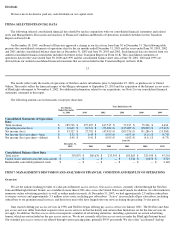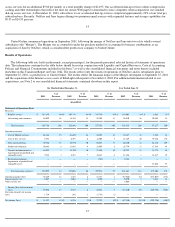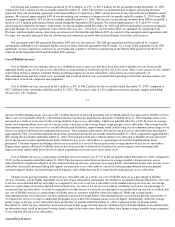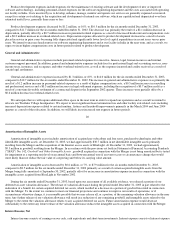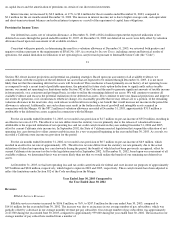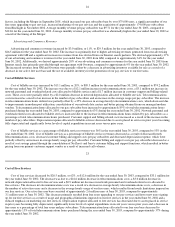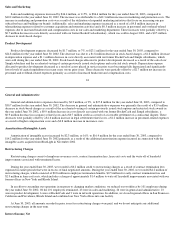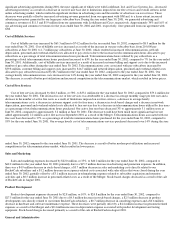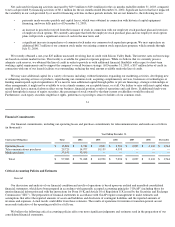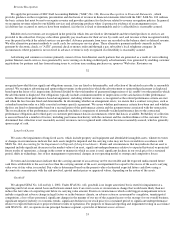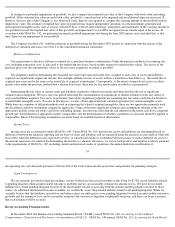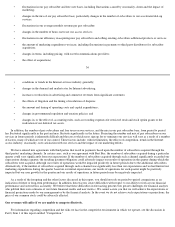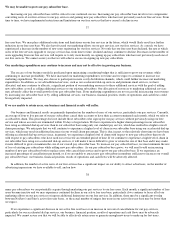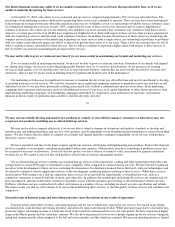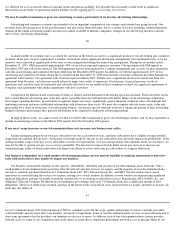Classmates.com 2003 Annual Report Download - page 22
Download and view the complete annual report
Please find page 22 of the 2003 Classmates.com annual report below. You can navigate through the pages in the report by either clicking on the pages listed below, or by using the keyword search tool below to find specific information within the annual report.
significant advertising agreements during 2001, the most significant of which were with LookSmart, Ltd. and Cisco Systems, Inc., decreased
advertising inventory as a result of a decrease in our free user base due to limitations imposed on our free services and overall softness in the
online advertising market, which resulted in significant declines in advertising rates and the number of advertisers on our services. These
decreases were partially offset by increased advertising revenue generated from our agreement with GM and, to a lesser extent, increased
advertising inventory generated by our larger pay subscriber base. During the year ended June 30, 2001, we generated advertising and
commerce revenues of $11.3 and $5.9 million from our agreements with LookSmart and Cisco, respectively. Approximately 34% and 16% of
our advertising and commerce revenues for the years ended June 30, 2002 and 2001, respectively, were generated from our agreement with
GM.
Cost of Billable Services
Cost of billable services increased by $65.3 million to $74.2 million for the year ended June 30, 2002, compared to $8.9 million for the
year ended June 30, 2001. Cost of billable services increased as a result of the increase in our pay subscriber base, from 210,000 pay
subscribers at June 30, 2001 to 1.7 million pay subscribers at June 30, 2002, which resulted in increased telecommunications, network
depreciation, personnel and overhead-related costs allocated to pay services due to the increase in telecommunication hours allocated to pay
subscribers as a percentage of total telecommunications hours purchased. Telecommunications hours utilized by pay subscribers as a
percentage of total telecommunications hours purchased increased to 63% for the year ended June 30, 2002, compared to 7% for the year ended
June 30, 2001. Additionally, cost of billable services increased as a result of increased customer billing and support costs due to the increased
number of pay subscribers during the year ended June 30, 2002. Telecommunications costs associated with pay subscribers increased by
$39.8 million, customer billing and support costs increased by $16.7 million and network depreciation, personnel and overhead-related costs
allocated to pay subscribers increased by $8.7 million for the year ended June 30, 2002, compared to the year ended June 30, 2001. Our
average hourly telecommunications costs decreased over 14% during the year ended June 30, 2002 compared to the year ended June 30, 2001.
The decrease is a result of better port utilization and increased competition in the telecommunications market, which resulted in lower prices.
Cost of Free Services
Cost of free services decreased by $46.3 million, or 58%, to $33.1 million for the year ended June 30, 2002, compared to $79.4 million for
the year ended June 30, 2001. The decrease in cost of free services was attributable to a decrease in average monthly usage per free user and a
decrease in the number of active free users as a result of limitations imposed on our free services, a decrease in average hourly
telecommunications costs, a decrease in customer support costs for free users, a decrease in stock-based charges and a decrease in network
depreciation, personnel and overhead-
related costs allocated to free services due to a decrease in telecommunication hours utilized by free users
as a percentage of total telecommunications hours purchased. Our active free user base decreased 3% to approximately 3.1 million users at
June 30, 2002, compared to approximately 3.2 million at June 30, 2001. The decrease would have been much more significant had we not
added approximately 2.2 million active free users in September 2001 as a result of the Merger. Telecommunications hours associated with our
free user base decreased to 37% as a percentage of total telecommunications hours purchased for the year ended June 30, 2002, compared to
93% for the year ended June 30, 2001. Our average hourly cost of telecommunications services purchased decreased over 14% during the year
27
ended June 30, 2002 compared to the year ended June 30, 2001. The decrease is a result of better modem port utilization and increased
competition in the telecommunications market, which resulted in lower prices.
Sales and Marketing
Sales and marketing expenses decreased by $22.0 million, or 35%, to $40.2 million for the year ended June 30, 2002, compared to
$62.2 million for the year ended June 30, 2001 primarily due to a $15.5 million decrease in advertising and promotion expenses. In addition,
there was a $4.9 million decrease in stock-based charges, a $3.7 million decrease in sales and marketing costs directly related to our
RocketCash subsidiary and a $1.2 million decrease in occupancy-related costs associated with sales offices that were closed during the year
ended June 30, 2002, partially offset by a $3.1 million increase in telemarketing expenses related to subscriber acquisition and retention
activities and a $0.5 million increase in personnel-related costs as a result of the Merger. Stock-based charges decreased as a result of the sale
of RocketCash in August 2001.
Product Development
Product development expenses decreased by $2.8 million, or 10%, to $24.8 million for the year ended June 30, 2002, compared to
$27.5 million for the year ended June 30, 2001 due to a $4.5 million decrease in stock-based charges, a $2.5 million decrease in product
development costs directly related to our former RocketCash subsidiary, a $0.7 million decrease in consulting expenses and a $0.6 million
decrease in hardware and software maintenance expense. These decreases were partially offset by a $4.4 million increase in personnel-related
expenses as a result of the Merger and a $0.4 million increase in depreciation expense associated with product development and testing
equipment. Stock-based charges decreased primarily as a result of the sale of RocketCash in August 2001.
General and Administrative


